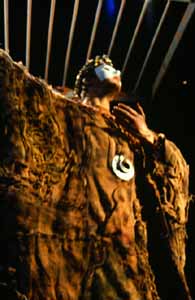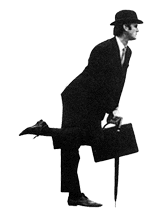
Theory of Spectatorship
THR221 Intermediate Acting

GeoAlaska: Theatre & Film


biomechanics.vtheatre.net
Spring 2003: Don Juan

film books

virtual theatre

ShowCases: 3 Sisters, Mikado, 12th Night, Hamlet, The Importance of Being Earnest, Dangerous Liaisons, Don Juan

The problem I face is the book System of the Method and the decisions about what belongs there, to Stanislavsky.
I am in the middle. I use both. I do not subscribe to Method or Biomechanics in full -- and my own criteria when and how to use one or another is based on the needs of Spectator.
Now, how does actor create TIME and SPACE?
You use THEIR (public) time!
You use THEIR (audience) space!
This is your material. They bring two-three hours of their real time with them to the theatre. Count it -- 3 X 300 = 900 hours to play with!
Three hundred (an example) of them in the house create the DRAMATIC space, which we usually call "stage" (Empty Space). Think of yourself in a scene at the top of this building with many levels under you, think of the iceberg! They, the public, is the "invisible" part of it (under the waters of darkness). Look at the Greek theatres; do you see how the energy of many is focused in one small place for ACTION.
You are welcome to be a part of this process of "writing" my book. I practice what I preach; you, the readers, are co-creators. Or should I say -- the main authors? All I do is trying to answer your questions, my questions, our questions...
Actor, you are SPECTATOR, never forget it!
Summary
... the Viewpoints method begins with actions and gestures, and uses them to generate the emotions that are at the heart of effective acting.
Questions
Rudolph Laban's system of analyzing movement has been used extensively in training performers. This program explains that his system analyzes movement according to three categories (direction, time and weight), which yield eight possible combinations that can define a movement. It shows acting students learning how to use Laban's eight effort actions to add variety and clarity to their physical work. [1997, 31 mins.]
One Act Fest
Notes
(New) four parts: Performance, Chronotope, Showcases, Theory -- to structure the pages in this directory. At another BM directory @ biomechanics.vtheatre.net (class) I use different breakdown (pre-text, text, post-text), which is even more confusing. "Pre-text" -- dramatic, words. "Post-text" -- spectator's text (dramatic experience). But what I can do? I have to keep term "text" for actual actors' performance.
2004 & After
Way of Acting the Theatre Writings of Tadashi Suzuki
Suzuki has articulated his theories in a number of books. A collection of his writings in English, "The Way of Acting" is published by the Theatre Communications Group of the U.S.A..
Not just one of the world's foremost theatre directors, Suzuki is an important theorist about performance. The Suzuki Method is a system of exercises, designed to be a realization of Suzuki's Philosophy. The cornerstone of this philosophy is a belief in the fact that human beings possess the ability to tap into the expressive power of animal energy, and that theatre, as a context for this expression, is socially and spiritually crucial in the present-day global situation.
 2009 LUL
2009 LUL
 & thr blog
& thr blog















